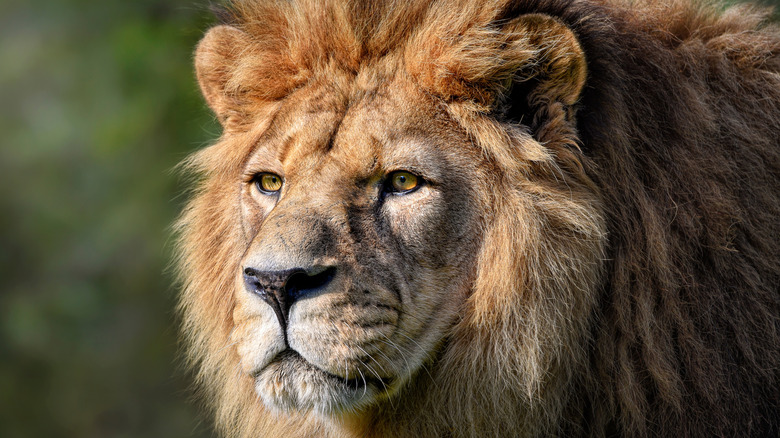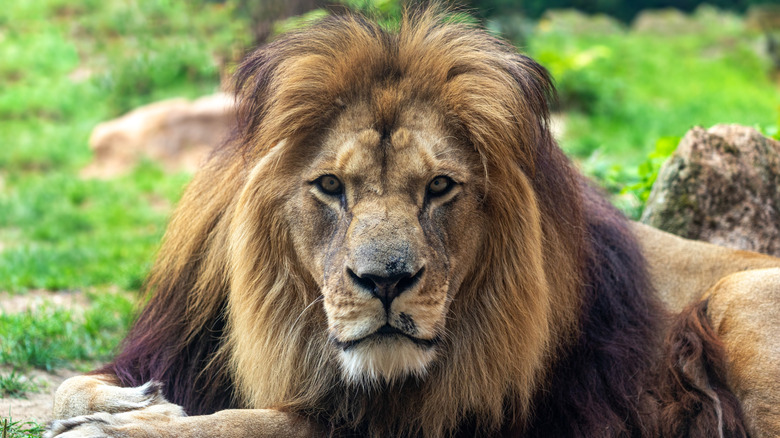The Tragic Reason Why The Barbary Lion Went Extinct
Given their size, grace, and regal bearing, lions are one of the most revered big cats. But there are several facts about lions that are concerning to say the least. Most notably, global lion numbers are in decline and things aren't looking good for their future. According to the African Wildlife Foundation, if things continue the way they're going, lions could go extinct by as soon as 2050. Indeed, these magnificent big cats were once found throughout most of Africa as well as parts of Asia and Europe, but have now lost 94% of their historical range, and today are only present in parts of sub-Saharan Africa (though a small number of the Asiatic lion subspecies still exists in India's Gir Forest).
A century ago there were roughly 200,000 lions in existence. Now, there are thought to be fewer than 23,000. What's more, while lions are yet to go extinct, several subspecies have been wiped out completely. All of which is a fairly grim picture in and of itself, especially when you consider that of all endangered species in Africa, lions aren't even the most imperiled. But when you look at why some of these subspecies have gone extinct, things start to look even more dreary.
The Barbary lion is one example. This subspecies, also known as the North African lion, Atlas lion, and Egyptian lion, once lived across North Africa in an area known as the Maghreb, which spans from Morocco to Egypt. Today, however, the Barbary lion has disappeared, and the reason for its disappearance is, at best, disquieting, and at worst, deeply upsetting.
Barbary lions were once abundant in North Africa
Historically there have been 11 documented subspecies of lion, but today only two survive. It should be noted, however, that lion taxonomy has been constantly evolving over the past century. In 2016, a study in Scientific Reports suggested a revision of lion taxonomy to incorporate a northern (Panthera leo leo) and a southern (P. l. melanochaita) subspecies of African lion. If we use that model, within the northern subspecies there are three subclades and one of these used to include the Barbary lion, or P. l. barbaricus.
The Barbary lion was quite different to the African lions of today, most notably in terms of the males' manes, which were darker than those of modern day African lions and extended further down the animals' backs. P. l. barbaricus also had a leaner physique and was thought to be the largest lion subspecies during its existence. As such, the Barbary lion was revered by humans, with the royal families of Morocco and other North African countries even keeping the animals at their palaces. Gladiators faced off against Barbary lions in the Roman Colosseum and the Tower of London once hosted several of the creatures in the royal menagerie. Today, however, these once mighty beasts have completely disappeared, and humans are to blame.
Humans ensured the extinction of the Barbary lion
Barbary lions, once widespread throughout Northern Africa, have now been completely wiped out. The story of their extinction is one of both human malevolence and indifference to their plight. We know the Romans used Barbary lions in the Colosseum but they also butchered thousands of the animals during their games and they weren't the only ones. The animals were also captured and killed throughout Arabia, Türkiye, and Europe far into the 19th century.
In Türkiye, authorities issued bounties for Barbary lions, while the French in Algeria also offered rewards for the creatures, resulting in mass killings between 1873 and 1883. This widespread hunting and killing of Barbary lions left the subspecies scattered across isolated areas in the 19th century, with small groups surviving in Morocco, Algeria, and Tunisia. It was once thought that the last of the Barbary lions was killed in Tunisia in 1891, and there were no sightings between 1901 and 1910. Then, the last photograph of one of the animals was captured in 1925, when an aerial photo showed a lone Barbary lion in the Atlas mountains of Morocco.
In 1942 a lioness was killed in the High Atlas mountains, and while this was also thought to have been the last wild Barbary lion, small groups remained in Algeria and Morocco, with sightings recorded up until the 1960s, as a 2013 study published in PLOS One revealed. As if being hunted and butchered to extinction wasn't enough, the Barbary lion faced a truly brutal coup de grâce when in 1958, during the French–Algerian War, the forests north of the Algerian city of Setif — the Barbary lion's final refuge — were destroyed.


